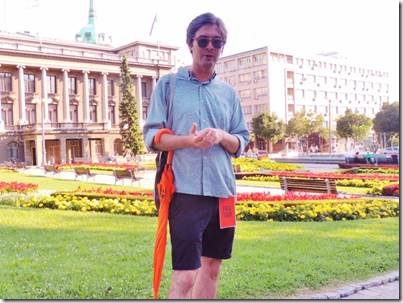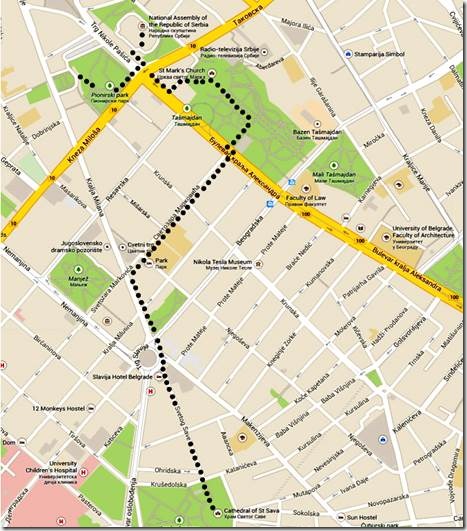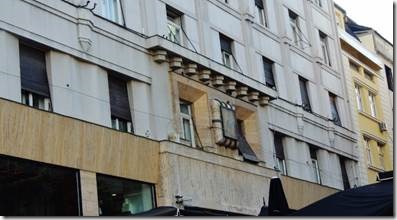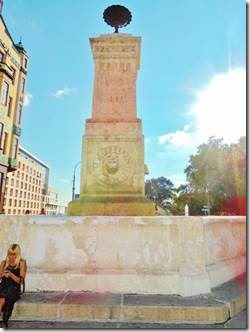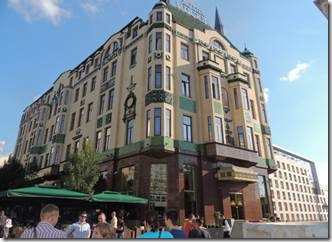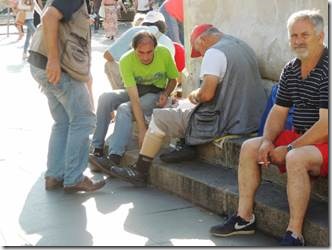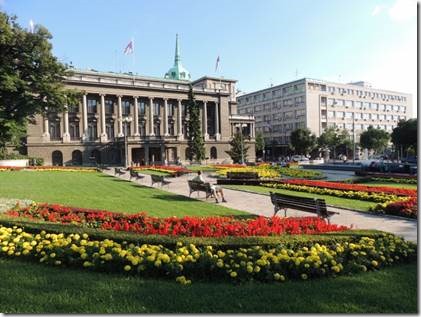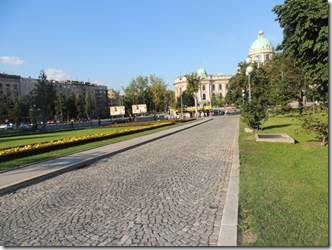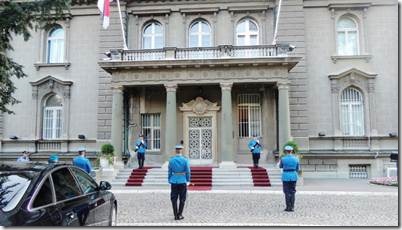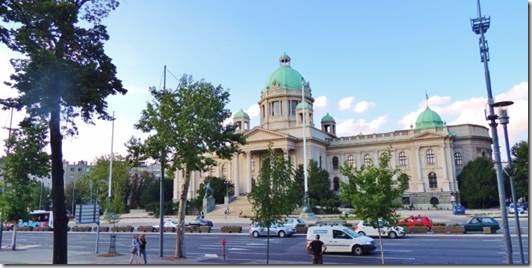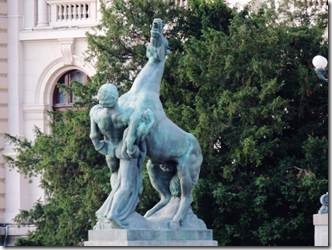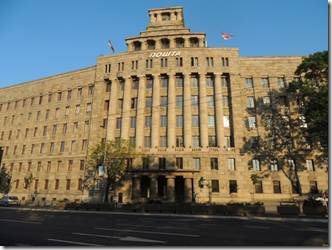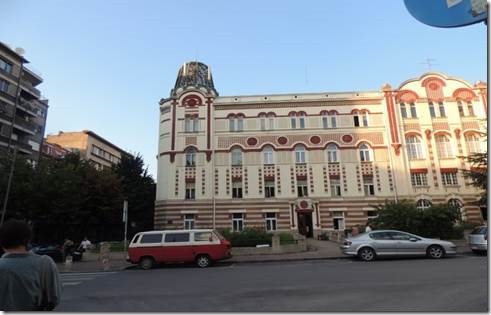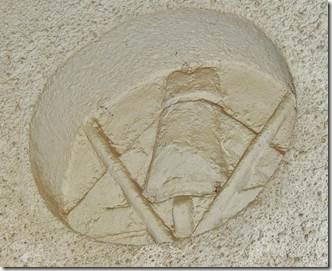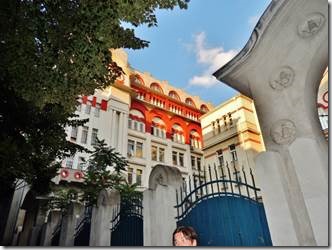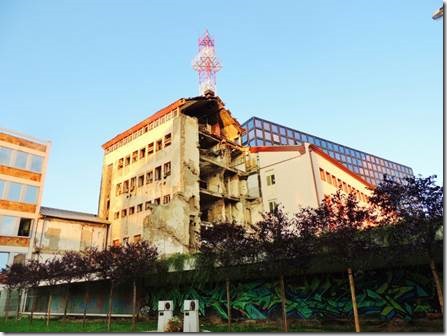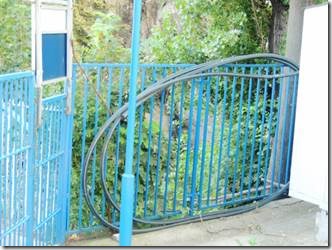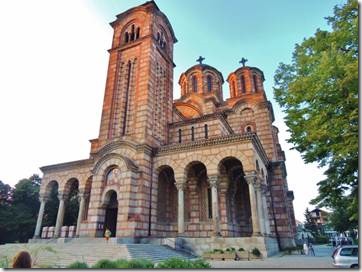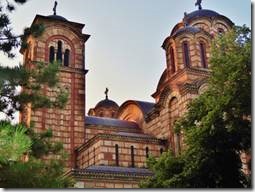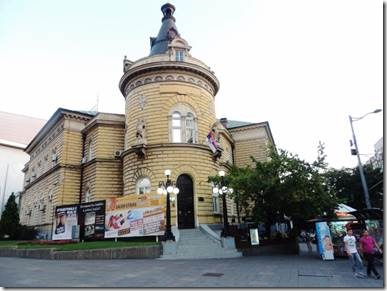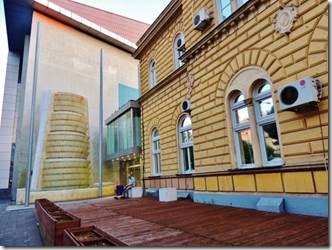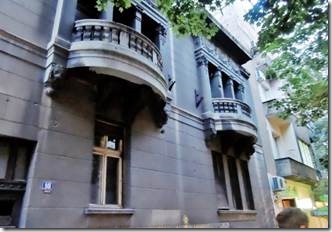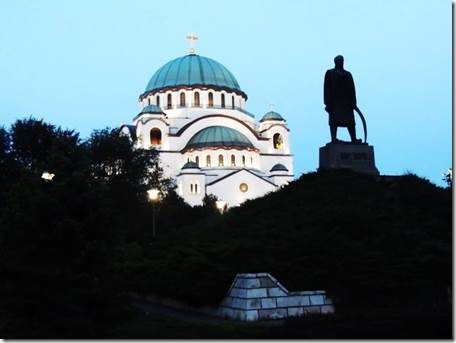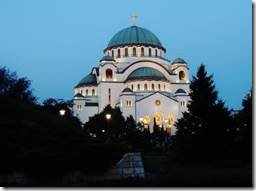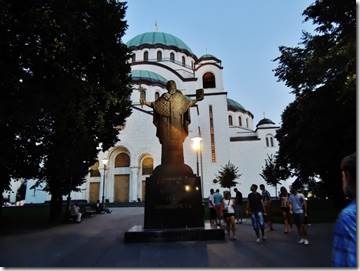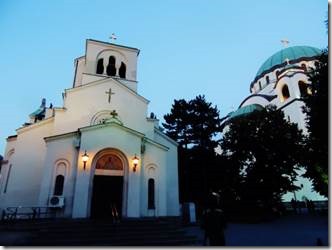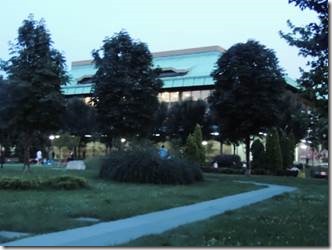Yacht Club Ruse
Ruse, Bulgaria
Здравей zdraveĭ Hello
I have never been so glad to finally finish an email as I am about this Belgrade evening walking tour story. Our guide was extremely knowledgeable and enthusiastic so there was a lot to take in. Some went in and stayed, lots went in and parts stayed, and some probably never made it in at all. There’s lots of text in this email. But the stories and history are really more important than the buildings and monuments. The Balkans really are the story of the people and what a mess politics has made through much of the history. But, you just have to root for the Serbian people. I really liked them. We all did.
I’ll do one following email about Belgrade but it will be mostly photos from when we just wandered around so not so mostly photos and little text.
I’m ashamed to admit that while researching these emails about Croatia, Serbia and next Bulgaria, I wonder where my mind was in the 90s while all this was happening. I know there were horror stories about Bosnia and Kosovo but I couldn’t tell you the players or what sides they were on. Now when the news mentions these places I will think of the people we met there.
Ru
Our guide Dusko (sp) who said he has lost about 18 kilograms since he’d started leading the free tours. That’s almost 40 pounds! He also works for an NGO in Belgrade something about social structures in society or something like that. Notice the orange umbrella…I think at least his third as they tend to get lost.
Discover the dark and mysterious side of Serbian history. Learn about the country’s dynasties, its Communist era, Tito, the rise and fall of Slobodan Milosevic, the bombing of Serbia and much more… See where the free masons left their hidden symbols embedded on buildings of national importance and together we shall solve all the hidden enigmas that lay within. Acquaint yourself with Serbian Orthodox tradition and the politics that molded this country.
•Old Palace
•The National Assembly building
•Tasmajdan Park
•Saint Mark’s Church
•Flower Square
•Slavia Square
•Saint Sava Temple
3 bridges and human shield / concert
This was a great tour with an extremely knowledgeable guide. I can only remember about 1/3rd of what I was told. Thankfully Randal and Rick remembered stories I didn’t. Basically this walk took us through the end of Turkish rule, WW1, WW2, the Cold War, Breakup of Yugoslavia and the disastrous rule of Slobodan Milosevic. Our tour guide pointed out what are said to be symbols of the Freemasons in Belgrade which fascinated him, but I’m still not so sure what the big deal is with that. The tour lasted almost 3 house and we had a 30 minute walk to the walk and a 40 minute walk back to DoraMac at the end of the tour. Sometimes though, instead of taking photos I should be taking notes. So I’ve pieced together information that covers the history of Serbia connected to the places we visited on our walk. Some of the sites, originally in Serbian, have “colorful” translations but that’s all that I could find using only the Internet and Not A Real Library.
Modern Serbia (1804-1918)
Serbian resistance to Ottoman domination, latent for many decades surfaced at the beginning of 19th century with the First and Second Serbian Uprising in 1804 and 1815. The Turkish Empire was already faced with a deep internal crisis without any hope of recuperating. This had a particularly hard effect on the Christian nations living under its rule. The Serbs launched not only a national revolution but a social one as well and gradually Serbia started to catch up with the European states with the introduction of the bourgeois society values. Resulting from the uprisings and subsequent wars against the Ottoman Empire, the independent Principality of Serbia was formed and granted international recognition in 1878.
This period was marked by the alternation of two dynasties descending from Djordje Petrovic – Karadjordje, leader of the First Serbian Uprising and Milos Obrenovic, leader of the Second Serbian Uprising. Further development of Serbia was characterized by general progress in economy, culture and arts, primarily due to a wise state policy of sending young people to European capitals to get an education. They all brought back a new spirit and a new system of values. One of the external manifestations of the transformation that the former Turkish province was going through was the proclamation of the Kingdom of Serbia in 1882.
Petar I Karadjordjevic
Prince Miloš Obrenović
Prince (later King) Milan Obrenović
Queen Natalia of Serbia. First a princess than an exiled Queen then a Regent for her son and then an exile again dying in France in 1941 having outlived her husband, son and daughter-in-law. http://royalmusingsblogspotcom.blogspot.com/
During Natalie’s reign she had her palace refurbished with several underground passages (necessary with all European court intrigue.) Her daughter-in-law refurbished the palace ultimately blocking some of the passages, one in particular with a heavy armoire. This redecoration had disastrous results.
Mihailo Obrenović (1823-1868, Prince of Serbia). The son of Prince Miloš and Princess Ljubica, he first came into power following the death of his elder brother Milan (1839). The sultan confirmed him to be an elected, but not a hereditary prince. Toma Vučić initiated an uprising in August 1842 and forced him into exile, bringing Alexander Karageorgevich to the throne. He spent six years outside the country and during this time assisted many Serbs working in literature (Vuk Karadžić, Đura Daničić, Branko Radičević and others). When Miloš returned to Serbia in 1858 Mihailo accompanied him and took over high command over the army. Regained the throne once more after the death of Prince Miloš in 1860. Established a national army with approximately 50,000 soldiers in 1861, aiming to finally rid Serbia of the Turks. Expecting war with Turkey he made alliances and agreements with other Balkan states – Montenegro, Greece, Bulgaria and Romania. Having finalized the preparations for war, he was assassinated during a walk in Košutnjak in 1868.
Two of the more interesting characters were Aleksander and Draga
Aleksandar Obrenović : The only child of Prince (later King) Milan (reigned 1868–89) and his consort, Natalie, Alexander ascended the Serbian throne on March 6 (Feb. 22), 1889, after his father had abdicated and named a regency council for the youthful Alexander. On April 13 (April 1), 1893, Alexander dismissed the regency council and assumed active control of the government.
Draga Lunjevica was born in 1861 to a wealthy and prominent Serbian family. Draga means “dear” in Serbian. She was married to a engineer named Svetozar MaÅ¡in at fifteen and widowed at eighteen. Draga served as a lady-in-waiting to Queen Natalia of Serbia. While working for Queen Natalia, Draga grew close to her son King Alexander. Rumor had it they met when she saved his life when he almost drowned in a fountain in the palace gardens.
Alexander had become King as a teenager when his father unexpectedly abdicated the throne for personal reasons. Alexander was guided by regents until he dismissed them and declared himself an adult at age seventeen. His father had sought the hand of a German or Austrian Princess for him to marry to secure the throne. But Alexander didn’t want to marry a Princess; he wanted Draga.
Draga was fifteen years his senior, had been married before, and though high ranking, was a commoner. Needless to say, she was unsuitable. It didn’t help that Draga’s family was known to be ambitious. She actually has a bit in common (in regards to background) with Elizabeth Woodville, another royal woman I’m researching for a post.
Draga was considered very intelligent. She spoke four languages, and was a member of the Serbian journalist society. She had edited and written for Serbian newspapers during her time as a lady-in-waiting. She was very well-read and interested in poetry.
Draga and Alexander were married in 1900. She was thirty-eight; he was twenty-three. The marriage was incredibly unpopular. There were protests and riots, and Draga was widely seen as unsuitable to be Queen. The Serbian people had also been hoping for a foreign marriage to a member of a royal dynasty. Alexander’s mother disapproved and refused to accept that there had been a marriage at all. Alexander had her banished for it. The public outcry was soothed slightly when Czar Nicholas II of Russia sent the couple congratulations, indicating he approved of the marriage.
Though rumors of a pregnancy were widespread, Draga was privately known to be infertile. Because of her family’s aspirations in place of a child of her own, Draga tried to have her younger brother named heir to the throne. Naturally, this was incredibly unpopular and the idea of a member of Draga’s family sitting on the throne made the people furious.
Alexander was also unpopular because he had disbanded the Serbian constitution twice and replaced it with whatever he wanted. Many of Alexander’s problems were blamed on Draga; popular opinion had him as a weak and delusional young man being controlled by an evil temptress. Draga was terrified her enemies would poison her and had all of her food tasted.
Draga and Alexander’s marriage began having problems only a year into it. His mother and other relatives were pressuring him to divorce Draga and marry someone more suitable. For her part, Draga thought Alexander was being corrupted by power and cared only for himself. But their marriage survived, partly out of Alexander’s problems with his parents’ separation when he was a child. Rumors were spread that Draga was trying to get her sister to have a baby and pass it off as her own. There was also a story that she had killed her first husband.
Things came to a head in March, 1903. There was widespread rioting around royal residences, and a growing anti-monarchist movement throughout Serbia. Draga and Alexander became increasingly paranoid as they found many of their friends and supporters abandoning them.
On June 10, 1903, Draga and Alexander dined with courtiers and members of Draga’s family at the Old Palace in Belgrade. That night, a riot formed and the crowd was lead by military leaders to the palace.
Draga and Alexander heard the crowd approaching and, terrified, hid in a cupboard in Draga’s bedroom. Draga’s sisters and most of the court were murdered as the mob stormed the palace. Draga and Alexander hid all night holding each other and trying to keep themselves quiet.
Alexander and Draga had been looking for Natalie’s secret passage but the cupboard had been built obscuring the passage.
They were found in the early hours of the morning and murdered. First they were shot at, and then they were stabbed and mutilated. Their bodies were thrown out the windows onto a pile of manure, and much of the palace was looted.
http://persephonemagazine.com/ is a more feminist version of Draga
The assassination of Austrian Crown Prince Franc Ferdinand in Sarajevo in 1914, served as a pretext for the Austrian attack on Serbia that marked the beginning of World War I. The Serbian Army bravely defended its country and won several major victories, but it was finally overpowered by the joint forces of Germany, Austria-Hungary and Bulgaria, and had to withdraw from the national territory marching across the Albanian mountain ranges to the Adriatic Sea. Having recuperated on Corfu the Serbian Army returned to combat on the Thessalonike front together with other Entante forces comprising France, England, Russia, Italy and the United States. In world War I Serbia had 1.264.000 casualties – 28% of its population (4.529.000) which also represented 58% of its male population – a loss it never fully recuperated from. This enormous sacrifice was the contribution Serbia gave to the Allied victory and the remodeling of Europe and of the World after World War I.
Serbia as a part of Yugoslavia (1918-1991)
Serbia was part of Yugoslavia from 1918 to 1991. This can be devided down to the following periods:
1918-1941 – The Kingdom of Yugoslavia
1941-1945 – The WWII
1945-1991 – SFR Yugoslavia
1991-1995 – The breakup of SFR Yugoslavia
The Kingdom of Yugoslavia (1918-1941)
With the end of World War I and the downfall of Austria-Hungary and the Ottoman Empire the conditions were met for proclaiming the Kingdom of Serbs, Croats and Slovenians in December of 1918. The Yugoslav ideal had long been cultivated by the intellectual circles of the three nations that gave the name to the country, but the international constellation of political forces and interests did not permit its implementation until then. However, after the war, idealist intellectuals gave way to politicians and the most influential Croatian politicians opposed the new state right from the start.
The Croatian Peasants’ Party (HSS) headed by Stjepan Radic, and then by Vlatko Macek slowly grew to become a massive party endorsing Croatian national interests. According to its leaders the Yugoslav state did not provide a satisfactory solution to the Croatian national question. They chose to conduct their political battle by systematically obstructing state institutions and making political coalitions to undermine the state unity, thus extorting certain concessions. Each political or economic issue was used as a pretext for raising the so-called "unsettled Croatian question".
Trying to match this challenge and prevent any further weakening of the country, King Aleksandar I banned national political parties in 1929, assumed executive power and renamed the country Yugoslavia. He hoped to curb separatist tendencies and mitigate nationalist passions. However the balance of power changed in international relations: in Italy and Germany Fascists and Nazis rose to power, and Stalin became the absolute ruler in the Soviet Union. None of these three states favored the policy pursued by Aleksandar I. In fact the first two wanted to revise the international treaties signed after World War I, and the Soviets were determined to regain their positions in Europe and pursue a more active international policy. Yugoslavia was an obstacle for these plans and King Aleksandar I was the pillar of the Yugoslav policy.
During an official visit to France in 1934, the king was assassinated in Marseilles by a member of VMRO – an extreme nationalist organization in Bulgaria that had plans to annex territories along the eastern and southern Yugoslav border – with the cooperation of the Ustashi – a Croatian fascist separatist organization. The international political scene in the late 30’s was marked by growing intolerance between the principal figures, by the aggressive attitude of the totalitarian regimes and by the certainty that the order set up after World War I is was loosing its strongholds and its sponsors were loosing their strength. Supported and pressured by Fascist Italy and nazi Germany, Croatian leader Vlatko Macek and his party managed to extort the creation of the Croatian banovina (administrative province) in 1939. The agreement specified that Croatia were to remain part of Yugoslavia, but it was hurriedly building an independent political identity in international relations.
World War II and its effects (1941-1945)
At the beginning of the 1940’s, Yugoslavia found itself surrounded by hostile countries. Except for Greece, all other neighboring countries had signed agreements with either Germany or Italy. Hitler was strongly pressuring Yugoslavia to join the Axis powers. The government was even prepared to reach a compromise with him, but the spirit in the country was completely different. Public demonstrations against Nazism prompted a brutal reaction. Luftwaffe bombed Belgrade and other major cities and in April 1941, the Axis powers occupied Yugoslavia and disintegrated it. The western parts of the country together with Bosnia and Herzegovina were turned into a Nazi puppet state called the Independent State of Croatia (NDH) and ruled by the Ustashe. Serbia was occupied by German troops, but the northern territories were annexed by Hungary, and eastern and southern territories to Bulgaria. Kosovo and Metohija were mostly annexed by Albania which was under the sponsorship of fascist Italy. Montenegro also lost territories to Albania and was then occupied by Italian troops. Slovenia was divided between Germany and Italy that also seized the islands in the Adriatic.
Following the Nazi example, the Independent State of Croatia established extermination camps and perpetrated an atrocious genocide killing over 750.000 Serbs, Jews and Gypsies. This holocaust set the historical and political backdrop for the civil war that broke out fifty years later in Croatia and Bosnia and Herzegovina and that accompanied the break-up of Yugoslavia in 1991-1992.
The ruthless attitude of the German occupation forces and the genocidal policy of the Croatian Ustasha regime generated a strong Serbian Resistance. The Serbs stood up against the Croatian genocidal government and the Nazi disintegration of Yugoslavia. Many joined the Partisan forces (National Liberation Army headed by Josib Broz Tito) in the liberation war and thus helped the Allied victory. By the end of 1944, with the help of the Red Army the Partisans liberated Serbia and by May 1945 the remaining Yugoslav territories, meeting up with the Allied forces in Hungary, Austria and Italy. Serbia and Yugoslavia were among the countries that had the greatest losses in the war: 1.700.000 (10.8% of the population) people were killed and national damages were estimated at 9.1 billion dollars according to the prices of that period.
Socialist Federal Republic of Yugoslavia (1945-1991)
While the war was still raging, in 1943, a revolutionary change of the social and state system was proclaimed with the abolition of monarchy in favor of the republic. Josip Broz Tito became the first president of the new – socialist – Yugoslavia. Once a predominantly agricultural country Yugoslavia was transformed into a mid-range industrial country, and acquired an international political reputation by supporting the de-colonization process and by assuming a leading role in the Non-Aligned Movement. Socialist Yugoslavia was established as a federal state comprising six republics: Serbia, Croatia, Slovenia, Bosnia and Herzegovina, Macedonia and Montenegro and two autonomous regions – Vojvodina and Kosovo and Metohija. The two autonomous regions were at the same time integral part of Serbia. Because of such an administrative division and due to historical reasons, the Serbs – the most numerous of the Yugoslav peoples – lived in all six republics and both autonomous regions. The trend to secure the power of the republics at the expense of the federal authorities became particularly intense after the adoption of the 1974 Constitution that encouraged the expansion of Croatian, Slovenian, Moslem and Albanian nationalism and secessionism.
The breakup of SFR Yugoslavia (1991-1995)
Between 1991 and 1992, Slovenia, Croatia and Bosnia and Herzegovina forcibly seceded from Yugoslavia, whilst Macedonia did so peacefully. The break-up of Yugoslavia was endorsed by the international powers that recognized the right of self-determination to all nations except the Serbs which generally wanted to continue living in Yugoslavia. The secessionist republics were quickly granted recognition by the international community in clear breach of the principle of inviolability of international borders of sovereign countries and without fulfilling the criteria that a given state has to meet to be recognized internationally. Serbia and Montenegro opted to stay on in the federation and at the combined session of the parliaments of Yugoslavia, Serbia and Montenegro held on April 27 1992 in Belgrade, the Constitution of the Federal Republic of Yugoslavia was passed thus reaffirming the continuity of the state first founded on December 1st 1918.
The dissolution of the State Union of Serbia and Montenegro (2006)
In February 2003, Republic of Serbia and Republic of Montenegro adopted a new Constitutional Charter that transformed FR Yugoslavia into the State Union of Serbia and Montenegro. The Charter gave rights to both member states to hold a referendum in three years and decide whether they would remain in the State Union. The Republic of Montenegro exercised this right in May 2006 and by popular vote decided to leave the State Union and declare its independence. On June 5, 2006, National Assembly of the Republic of Serbia passed a conclusion that the Republic of Serbia is a state and a legal successor of the State Union of Serbia and Montenegro.
|
Republic Square and the end of Slobodan Milosevic. This should have been our final stop rather than the first one, but the tour met in Republic Square and our guide pointed out this balcony that Rick and Randal remembered as the site of a speech after the revolution. “Which revolution?” I asked. Neither was sure but they were pretty sure it was recent times. Maybe the speech after the end of Milosevic. Balcony and clock in Republic Square In more recent past, Republic Square was unofficially renamed Freedom Square. Starting from 1991 and for the next ten and more years, opposition (to Milošević’s regime and later anti-democrats) held their rallies there. The first rally was held on 9th March 1991, when demonstrators requested change of National television director. Soon this protest escalated into a clash with police, which tried to prevent it. http://www.belgradian.com/
Slobodan Milosevic, 64, Former Yugoslav Leader Accused of War Crimes, Dies MARLISE SIMONS and ALISON SMALE Published: March 12, 2006 PARIS, March 11 — Slobodan Milosevic, the Communist leader whose embrace of Serbian nationalism set off almost a decade of Balkan warfare, was found dead early Saturday in his cell at the United Nations detention center in The Hague, where he had been since 2001. He was 64. Mr. Milosevic appeared to have died from natural causes, but tribunal officials said they would not be able to give a full account until an autopsy and toxicological report were completed. He was found lifeless on his bed in his cell, a court statement said. Mr. Milosevic’s wife, and his partner of almost five decades, Mirjana Markovic, who, like his brother, Borislav, is living in Moscow, was informed of Mr. Milosevic’s death, the court said. Death came as Mr. Milosevic’s four-year trial for war crimes, crimes against humanity and genocide was drawing to a close. A verdict had been expected later this year. He was the first former head of state to answer charges of such crimes and his was the longest war-crimes trial of modern times, delayed by Mr. Milosevic’s frequent bouts of illness related to high blood pressure and a bad heart. The complex indictment covered the events of three wars — in Croatia, Bosnia and Kosovo — and almost a decade of bloodshed and vengeance that killed more than 200,000 people and earned Mr. Milosevic the sobriquet "Butcher of the Balkans." On the advice of medical specialists, Mr. Milosevic went to court only three days a week. A lawyer by training, he insisted on conducting his own defense, often speaking for hours and summoning witnesses, including, just last month, former President Bill Clinton, who declined. Although Mr. Milosevic had become less blustery of late, his trademark defiance allowed him to act the role of martyr for the Serbian cause until the very end. In December, Mr. Milosevic asked to travel to Moscow for medical treatment. The judges in The Hague refused to let him leave, arguing that adequate treatment was available in the Netherlands. Fueling Nationalist Grudges As he rose and then clung to power by resurrecting old nationalist grudges and inciting dreams of a Greater Serbia, Mr. Milosevic became the prime engineer of wars that pitted his fellow Serbs against the Slovenes, the Croats, the Bosnians, the Albanians of Kosovo and ultimately the combined forces of the entire NATO alliance. By stirring a dormant but incendiary nationalism, he succeeded in rallying support for himself in the late 1980’s, at a time when Communism in the rest of Eastern Europe was in its death throes. Exercising carefully calculated control of the media and operating ruthlessly behind the scenes, Mr. Milosevic established a cult of personality that struck fear into non-Serbs in Yugoslavia. The Croats reacted by turning to their own nationalist, Franjo Tudjman, and so the stage was set for a deadly showdown between Yugoslavia’s two largest ethnic groups, whose leaders manipulated centuries of historical differences — the Serbs are Orthodox Christians, the Croats Roman Catholic; the Serbs endured Ottoman rule, the Croats the Hapsburgs — into a brutal civil war that spread from Croatia into Bosnia-Herzegovina. There, the Muslim plurality led by Alija Izetbegovic proved powerless to enlist sufficient international support to prevent Mr. Milosevic and Mr. Tudjman from trying to dismember his state. Three and a half years of war ravaged Bosnia, leading to some 200,000 deaths and the eviction of millions from homes in a practice that became known globally as ethnic cleansing. The consequences of Mr. Milosevic’s rule for Serbia were devastating. His final confrontation, with the Albanians of Kosovo, provoked a NATO bombing assault in the spring of 1999 that destroyed government buildings, factories and much infrastructure in a land already ruined by years of international sanctions intended to punish Mr. Milosevic for instigating earlier wars. As Stojan Cerovic of the independent Belgrade weekly Vreme once wrote, "he turned Serbia into a colossal ruin." By the fall of 2000, even Mr. Milosevic’s appeals to nationalism and blatant manipulation of every election he contested were no longer enough to sustain him in power. Opposition forces who had mustered huge street protests, in 1991 and 1996, to try to oust Mr. Milosevic finally succeeded in October 2000. Security forces, who had helped Mr. Milosevic carve out large chunks of Croatia and Bosnia for Serbs and then served his cause in Kosovo, turned against him and joined opposition forces led by Vojislav Kostunica, who had beaten Mr. Milosevic in a presidential election that the Serbian leader refused to recognize. ……. Although he ended his days in a jail cell, Mr. Milosevic carved an indelible mark on the 20th century history of Europe. Mr. Babic, the erstwhile Milosevic ally who died just days before his onetime patron, summed up Mr. Milosevic’s legacy when testifying against him in The Hague in 2002. "You brought shame upon the Serbian people," he said. "You brought misfortune on the Croatian people, on the Muslim people" and "orchestrated" the Balkan conflict. Indeed, Mr. Milosevic dashed all the joy that came with the fall of the Berlin Wall and the crumbling of Communism across the rest of Eastern Europe. "At a time when there was real optimism in Europe, Milosevic almost single-handedly — with help from some Croats and some Serbs — managed to plunge Europe into a profound crisis," said Misha Glenny, a British expert on the Balkans. "Even in Serbia, there will be few people mourning his death because he did great damage to Serbia, as he did to other Yugoslav republics." http://www.nytimes.com/ has the full obituary which tells a good deal about Serbia and the Balkans during the time of Milosevic. If you want to start a peaceful revolution, the person to call is a Serb with a passion for Tolkien. Srdja Popovic is advising rebels in 40 countries. Emma Williams watches him at work and at home… From INTELLIGENT LIFE magazine, May/June 2012 http://moreintelligentlife.com/content/ideas/a-velvet-fist?page=full |
|
Terazije Square Covers the area from Sremska Street to Srpskih vladara Street. Terazije is the most famous square in Belgrade. It started to take shape as an urban feature in the first half of the 19th century. In the 1840s, Prince Miloš Obrenović ordered Serbian craftsmen, especially blacksmiths and coppersmiths, to move out of the old moated town where they had been intermingling with the Turkish inhabitants, and build their houses and shops on the site of the present-day square. With regard to the origin of the name Terazije, the historian Milan Đ. Milicević (b. Ripanj 1831, d. Belgrade 1908) noted that "In order to supply Belgrade with water, the Turks built towers at intervals along the water supply system which brought water in from the springs at Mokri Lug. The water was piped up into the towers for the purpose of increasing the pressure, in order to carry it further." One such tower was erected on the site of the present drinking-fountain in Terazije and the square was named after it the Turks called their water towers terazije za vodu (scales for water). Up to about 1865, the buildings on Terazije were mainly single and double storey ones. The water was removed in 1860 and replaced by the drinking-fountain, which was erected in memory of Prince Miloš who had died the same year. During the first reconstruction of the square in 1911, the fountain was moved to Topcider; it did not return to Terazije: until 1976. Terazije acquired its definitive form during its last reconstruction in 1947-48, when its flower beds, fountain and tram-lines were all removed. Later, in 1971, pedestrian subways were built joining the two sides of the square. In 1976, in the space between the Moskva and Balkan Hotels, the old Terazije fountain was installed. This was originally built in 1860, to commemorate the death of Prince Miloš Obilić: from 1911 to 1976, this fountain, one of Belgrade’s most important 19th century monuments, was located in Topčider Park. Benches have been arranged around it, and it is now a favourite place of Belgraders to stroll or rest. http://web.mit.edu/most/www/ser/Belgrade/trg_terazije.html “On a place of today’s fountain used to stand one plain fountain, which was replaced by the order of Prince Miloš Obrenović with the existing Terazije Fountain in 1859. This fountain, known after four lion heads (hard to see the heads but they’re there) from whose mouth flows cold water, is one of prominent symbols of Belgrade. At one point it was relocated to Topčider Park and forgotten, but after almost 65 years, it was restored and returned to its original location where it stands until today. Terazije Fountain is not just one of main meeting points in the city, but as well a place where people, young and old, exchange stickers for various collector albums during summer time. (like trading cards only they’re stickers.) http://www.belgradian.com/belgrade-walks/tram-no.2-walk/ “The building of the Hotel Moscow was the biggest one in private possession in the Serbian Kingdom . Back then the building was named Rosija Palace. A hundred meters from it, on Terazije, was the King’s castle. The King himself opened the Palace On 16th of January 1908 Rosija Palace – nowadays Hotel Moscow, was opened by the King Petar I Karadjordjevic, with the orchestra. In Rosija Palace there was a hotel, café, restaurant, flats to rent and offices of Belgrade branch of Insurance company Rosija Under the state protection The Hotel Moscow was built in the style of Russian secession, with skillfully combined elements of Greek antiquity. In the 20th century, Hotel Moscow became the most famous catering facility in Belgrade. In mid 20th century it was declared a monument of culture under the state protection. http://www.hotelmoskva.rs/hotel-2/the-history/?lang=en Sticker traders |
|
Old Palace Former Royal Courts (known as Old and New) lie opposite to Republic Parliament and next to Pionirski Park. Palaces were heavily damaged during both World Wars, which resulted in significantly altered exterior compared to original buildings appearance. Old Court was built in style of academism between 1882 and 1884 and used by Obrenović ruling dynasty. In the time of construction, it was supposed to be larger than any other residence in Serbia. Even today, Old Court is considered one of the finest and most beautiful examples of academism in Serbia. Unfortunately, Old Court was place of one of the most hideous assassinations in Serbian history. In the night between 28 and 29 May 1903, conspirators savagely killed King Aleksandar and his wife Draga and threw them from the balcony on the second floor to the street. Today, Old court houses the Assembly of the City of Belgrade and the cabinet of the mayor. New Court was built between 1911 an 1912 by order of ruling family Karadjordjević and it was the official residence of King Aleksandar Karadjordjević. For a certain period, palace served as Museum of Prince Pavle and from 1948, it became official "house" of Assembly of Serbia. Currently, president of Serbia uses New Court as his official office. http://www.belgradian.com/belgrade-walks/tram-no.2-walk/ While we were at the Palaces our guide Dusko discussed the assassination of Archduke Franz Ferdinand by Serbian Gavrilo Princip, a member of The Black Hand movement which wanted Serbia free form Austro-Hungarian rule. This was one of the acts that precipitated the start of WW 1. “Gavrilo Princip, who happened to be in Franz Joseph Street at a cafe, seized his opportunity, and took aim at Ferdinand from a distance of five feet. His bullets struck the Archduke in the neck and his wife, Sophie, who was travelling with him, in the abdomen. Urban drove the car to the governor’s residence at Konak; the couple died soon afterwards. Gavrilo Princip being taken into custody following the Assassination of Franz Ferdinand, 28 June 1914After the shooting Princip made to turn his gun upon himself but was seized and restrained by a man nearby, aided by several policemen. He was arrested and taken to a police station. In total eight men were charged with treason and Franz Ferdinand’s murder. However under Austro-Hungarian law capital punishment could not be applied to anyone under the age of 20 when the crime was committed. Gavrilo Princip, whose precise date of birth could not be firmly established at his trial, was therefore imprisoned for the maximum duration, twenty years. He died however of tuberculosis on 28 April 1918. “http://www.firstworldwar.com/bio/princip.htm Tasmajdan Park “Once upon a time, in the period of the Ottoman rule, there was a quarry in the area of today’s Tasmajdan park. Hence the name of the park – tas meaning stone in Turkish and majdan meaning a mine. The Tasmajdan caves, recently open to public, have testified to the turbulent history of Belgrade for two thousand years, ever since the Celtic and Roman conquests, Ottoman, Austro-Hungarian and German occupation to these very days. During the siege of Belgrade, in 1806, the leader of the First Serbian Uprising and the founder of one of the two modern Serbian dynasties, Karađorđe, set up a camp in that area and the catacombs served as ammunition storage, while in the Second World War they were also used as shelters. The dominant edifice in the Tašmajdan park is St Mark’s Church, originally built in 1835, at the site where, five years before, the political self-rule of Serbia within the Ottoman Empire was acknowledged, with Prince Milos Obrenovic at the helm. The church was reduced to rubble during the German bombing of Belgrade on 6 April 2011. A new church, today’s Church of St Mark, had already been built in its vicinity. Not far from it there is a Russian church, the Church of St Trinity, built in 1924, in the period where numerous Russian emigrants arrived in Serbia after the October Revolution. Not far from the park there is the Main Post Office building, built in 1934, which still today represents one of the most beautiful edifices of Belgrade. There is also a sports centre, as well as famous taverns „Madera“ and „Šansa“ in the vicinity.” http://voiceofserbia.org/ |
|
A very modest changing of the guard. |
|
The Federal or Republic Parliament, also known as House of the National Assembly, had unpleasant role to represent all failed states that came one after another. The name "federal" is inherited from the time of the Socialist Federal Republic of Yugoslavia, which was the first user of the building. After disintegration of Yugoslavia, our state changed its name three times, and so did the Parliament. During the 90s, this building was symbol of instability and bad ideology. In 2006, the cycle of wandering was concluded and Parliament officially became the House of the National Assembly of Serbia. After almost four decades of planning, Parliament was finally built in 1936. Building was considered to be cursed because it is built on a Roman graveyard. Even more, somebody made up that the building of Parliament was delayed due to a prophecy that King Aleksandar Karadjordjević will be killed upon its completion. Indeed king was killed, but two years before it was finished. Parliament stands today not only as a House of Assembly, but also as a monument of culture since the most famous architects, designers and artist of their time took part in designing of Parliament. Special attentions should be paid to the sculpture "Play of Black Horses" of renowned Serbian sculpture Toma Rosandić that stands in front of the Parliament entrance. http://www.belgradian.com/belgrade-walks/tram-no.2-walk/ During the 18th and 19th century, this was the sight of Belgrade’s most imposing and most beautiful mosque – Batal džamija, and the largest graveyard in the city. The Parliament palace construction started in 1906 intended for the National Assembly of Serbia, but it wasn’t completed until the thirties, when it started serving as the Parliament of Yugoslavia. It has since then witnessed and shared the fate of the city. http://belgrademyway.com Construction on the building started in 1907, with the cornerstone being laid by King Petar I. The building was based on a design made by Konstantin Jovanovic in 1891; a variant of that design made by Jovan Ilkic, which won a competition in 1901. World War I delayed construction, and the original plans to the building were lost. Reconstruction of the plans were made by Ilkic’s son Pavle. The interior was designed by Nikolaj Krasnov. It was designed in the manner of academic traditionalism. The construction of the building was completed in 1936 and the first session in the new edifice was held on October 20 of the same year. At the time, it was the National Assembly of the Kingdom of Yugoslavia. In September 1939, the Assembly was dissolved and during the Second World War it was occupied by the aggressor’s civil administration for Serbia. Several decades after the end of the war, this was the building of the Assembly of the Socialist Federal Republic of Yugoslavia. After the dissolution of Yugoslavia, in the 1990s, this edifice became the seat of the Assembly of the Federal Republic of Yugoslavia, and later the seat of the Parliament of Serbia and Montenegro. On June 5, 2006, Serbia became an independent republic, thus, the parliament building became the House of the National Assembly of the Republic of Serbia. http://www.waymarking.com Black Horses at Play : Toma Rosandić (Kralja Aleksandra Boulevard; set up in 1938) Composition ”Black Horses at Play” created in bronze and placed in front of the Serbian Assembly. It is the work of the famous sculptor Toma Rosandića. Thus, the playful horses came before the Board Rosandića 1938th years and today there are the eternal watch. For this sculpture are two related anecdotes. The first is actually a joke, which is told in Belgrade that the two sculptures of the poetic names do not mean just the game and the struggle between man and nature, but to a man who symbolizes the horse, and it will tell MPs, without any resistance introduced in the Assembly, and other shows wild horses that are trying hard to man out of the Assembly. Other stories, recent, says that someone from Croatia, when the "big Yugoslavia" broke up, raised the question that these two sculptures returned Croatia, because from there and came to Belgrade. http://www.tob.rs/en/see_in.php?id=54 This somewhat stilted translation is all I could find, but it somewhat matches what Dusco told us. Wish I could read what the sculptor was really thinking. |
|
Post Office “The Main Post Office on the corner of Takovska and King Aleksandar’s Boulevard was built from 1935 to 1938 for two highest state institutions: the Main Post Office and the Postal Savings Bank. ……. The modification of the modern concept of the floor plan of the building into representative academic style was demanded from the top Yugoslav echelons specifically, by king Aleksandar Karadjordjević in person. Such architectural concept, calling for representative and monumental character in public buildings, designed in the style of high academism, served as visual presentation of strength and prosperity of the new Yugoslav state and its capital, Belgrade. “ http://sajkaca.blogspot.com/2009/05/main-post-office-in-belgrade.html |
|
The Former Main Telephone Exchange (Kosovska Street 47 in Belgarde) is a unique building, made in 1908 in the spirit of serbian-national style. The architect was Branko Tanazevic (1876-1945). He combined byzantine elements, secessionist elements and moravian style elements in his buldings and created artistically intreesting bulidng that wer representative for serbian identity. He didn’t do it in a traditional way but more in a contemporary way. In its time, the buildings lookt really modern. http://sajkaca.blogspot.com/2009/06/former-main-telephone-exchange-in.html This building has a connection with the freemasons but none of us can remember the historic figure connected with it. The masonic symbols are fairly obvious. “Exhibition “Freemasonry in Serbia 1785-2014″ opens in Belgrade A considerable part of the exhibition is devoted to renowned Serbian Freemasons of the past, including industrialist Djordje Vajfert, author, philosopher and ‘enlightener of the people’ Dositej Obradovic, Serbia’s greatest linguist and language reformer Vuk Karadzic, King Petar I, scientist of great historical significance Mihajlo Pupin, King Aleksandar, politician Slobodan Jovanovic, Prince Pavle, Montenegrin ruler and poet Petar Petrovic Njegos and author Branislav Nusic.” |
|
“The turn of the century was marked by fierce political fighting between the different political parties in Serbia. Brothers from the Lodge ‘Pobratim’, themselves members of opposing political parties, were bringing their frustrations into the Lodge, which in 1903 resulted in the suspension of regular work of the Lodge, which lasted until 1905 when with the permission of the Grand Lodge of Hungary, the work of the Lodge was resumed. During these turbulent years (1900-1903), George Weifert , who was not a member of any political party, distanced himself from Lodge meetings as they have come to resemble a political debate society rather than a Masonic meeting. This was the time of the first attacks on Freemasonry in Serbia. The Lodge ‘Pobratim’ and its connection with the Grand Lodge of Hungary provoked some newspapers to attack Freemasons as ‘advocates of Austrian, pro-Catholic incursion into Serbia’. Membership in the Fraternity consisted of many eminent representatives of public life in Serbia, like Bro. George Weifert whose impeccable character and patriotism were beyond any doubt. This prevented stronger and more persistent anti-Masonic charges. …….. with King Peter Karageorgevich or his son Prince Aleksandar as the Grand Master. It is believed that King Peter and his son were both Freemasons…….” http://www.djordje-vajfert.org/en/djv_mason.htm http://www.balkaninside.com/famous-serbian-freemasons/ a site about famous Serbs who were freemasons. |
|
The NATO bombing of the Radio Television of Serbia headquarters occurred on 23 April 1999, during the “Kosovo War”. It formed part of NATO’s aerial campaign against the Federal Republic of Yugoslavia, and severely damaged the Belgrade headquarters of RTS. Sixteen employees of RTS died when a single NATO missile hit the building. Jelica Munitlak (28) make-up artist, Ksenija Bankovic (28) video mixer, Darko Stiomenovski (26) Technician in exchange, Nebojsa Stojanovic (27) and Branislav Jovanovic (50) TV technicians, Dragorad Dragojevic (27), Dejan Markovic (39) and Milan Joksimovic (47) security guards, Dragan Tasic (31) electrician, Aleksandar Deletic (31) cameraman, Slavisa Stevanovic (32) and Ivan Stukalo (34) technicians, Sinisa Medic (32) Programme designer, Milan Jankovic (59) technician, Tomislav Mitrovic (61) Programme Director and Slobodan Jontic (54) technician were killed at 2:06 a.m. Serb TV station was legitimate target, says Blair By Richard Norton-Taylor theguardian.com, Saturday 24 April 1999 03.20 BST http://www.theguardian.com/world/1999/apr/24/balkans3 The Amnesty report is similar in its findings to a detailed report by Human Rights Watch in February. Of the 500 or so Yugoslav civilians killed in Serbia and Kosovo by NATO bombs, half died because of NATO violations of laws and practices on protecting civilians, said Kenneth Roth, executive director of Human Rights Watch, in a telephone interview from New York. Amnesty was scathing about the bombing of the television station, which went off the air only briefly. ”NATO deliberately attacked a civilian object, killing 16 civilians, for the purpose of disrupting Serb television broadcasts in the middle of the night for approximately three hours.” Dusko hinted that higher ups had some idea the station would be bombed and left leaving the others to be killed for propaganda reasons. “Thousands of Serbs formed human shields to protect key bridges during another night of Nato bombing. Serb media said senior politicians joined crowds at a rock concert on the Brankov bridge in Belgrade. Similar demonstrations were also reported in the northern town of Novi Sad. There were no reports that bridges were hit overnight, although a Pentagon statement said such action would not protect targets.” http://news.bbc.co.uk/2/hi/europe/314953.stm Katrina had told us about the human shield at a rock concert held on a bridge. |
|
Just across from the demolished TV Station is this locked gate. Below are unexploded WW 2 German mines. I did read that one huge bomb was found during construction in Belgrade in 2013 but was defused. |
|
St. Marks Church was erected on a place of destroyed church of the same name. It was built in Serbian-Byzantine style, resembling the church of Gračanica Monastery. It is one of the biggest churches in Belgrade and it can seat around 2,000 people at the same time. Despite the fact that construction of the church is finished more than 70 years ago, interior is not finished yet. It possesses a valuable collection of icons and iconostasis. St. Mark’s Church is the resting place of emperor Dušan the Mighty (in whose time Serbia reached Corinth) and the royal couple Aleksandar Obrenović and Draga Mašin, who were killed by conspirators. |
|
SKC – The Belgrade Student Culture Center: where performance art in Belgrade began SKC was one of several student culture centers established in cities across Yugoslavia following the student protests of 1968, as a way to contain the potentially rebellious activity of Yugoslav youth. Tito’s approach was to give young people a place to express themselves, but in a controlled environment, which was not in the public domain. In the 1970s, SKC in Belgrade was the location of some of the most experimental art being produced, including performance art, conceptual art and installation. And of course it cannot be forgotten that it was at SKC where Marina Abramovic created some of her first performances, together with fellow artists Rada Todosijevic, Nesa Paripovic (her first husband), Zoran Popovic, Era Milivojevic, and Gergelj Urkom. SKC was not just a space where artists were free to experiment, and in which they held numerous exhibitions and performances, but it was a meeting point, a place where the artists came every day to talk about art, and where artists from abroad would also come and participate in that exchange of ideas. And this is the story that is not often told in "the West," at least not in any of the books on performance art that I’ve read – that these artists working in Belgrade (including those who came from other parts of Yugoslavia) were very much a part of the story of the development of the genre of performance art, right from the beginning – and they were really at the heart of that story. In a way, SKC was a "free space," but it was a type of controlled freedom, of which the artists were aware. They were also aware, however, that what they were doing was on the margins, and for that reason, the authorities and official institutions didn’t take them seriously, and pretty much left them alone. And in that environment, for a very brief but shining moment, performance art and avant-garde activity thrived, especially during the period of 1972-1977, in the context of the April Meetings. The Student Culture Center is still open and active, but unfortunately the creative spirit that was generated there is now mostly a memory http://performingtheeast.com/blog/ Performance art and student protests http://www.theguardian.com/ Marina Abramovic one of the most famous artists connected to the Center |
|
Fountain was gathering place during student protest days. |
|
Refusal and then agreement to join the Nazi : documents were signed here. Crown Prince Peter, now Peter II, was 11 years old. His cousin, Prince Paul of Yugoslavia (nephew of Peter I), led the regency that ruled Yugoslavia, and signed on to the Axis pact between Germany, Italy, and Japan, effectively making Yugoslavia an ally of Nazi Germany and receiving a promise of territorial integrity in exchange, a few months before the king was to ascend to his throne on his 18th birthday. Two days later, a military coup led by the Yugoslav air force commander overthrew the regency and installed the 17-year-old Peter II as king. A couple weeks later, Yugoslavia fell and Peter II was a 17-year-old king without a country, having fled to the Middle East after escaping by climbing down a drainpipe; by 1945, he could no longer return home. http://www.chicagomag.com/ is a really interesting article about Peter II “At the beginning of the 40’s, Yugoslavia found itself surrounded by hostile countries. Except for Greece, all other neighboring countries had signed agreements with either Germany or Italy. Hitler was strongly pressuring Yugoslavia to join the Axis powers. The government was even prepared to reach a compromise with him, but the spirit in the country was completely different. Public demonstrations against Nazism prompted a brutal reaction. Luftwaffe bombed Belgrade and other major cities and in April 1941, the Axis powers occupied Yugoslavia and disintegrated it. The western parts of the country together with Bosnia and Herzegovina were turned into a Nazi puppet state called the Independent State of Croatia (NDH) and ruled by the Ustashe. Serbia was occupied by German troops, but the northern territories were annexed by Hungary, and eastern and southern territories to Bulgaria. Kosovo and Metohija were mostly annexed by Albania which was under the sponsorship of fascist Italy. Montenegro also lost territories to Albania and was then occupied by Italian troops. Slovenia was divided between Germany and Italy that also seized the islands in the Adriatic. Following the Nazi example, the Independent State of Croatia established extermination camps and perpetrated an atrocious genocide killing over 750.000 Serbs, Jews and Gypsies. This holocaust set the historical and political backdrop for the civil war that broke out fifty years later in Croatia and Bosnia and Herzegovina and that accompanied the break-up of Yugoslavia in 1991-1992. The ruthless attitude of the German occupation forces and the genocidal policy of the Croatian Ustasha regime generated a strong Serbian Resistance. The Serbs stood up against the Croatian genocidal government and the Nazi disintegration of Yugoslavia. Many joined the Partisan forces (National Liberation Army headed by Josip Broz Tito) in the liberation war and thus helped the Allied victory. By the end of 1944, with the help of the Red Army the Partisans liberated Serbia and by May 1945 the remaining Yugoslav territories, meeting up with the Allied forces in Hungary, Austria and Italy. Serbia and Yugoslavia were among the countries that had the greatest losses in the war: 1.700.000 (10.8% of the population) people were killed and national damages were estimated at 9.1 billion dollars according to the prices of that period. http://www.serbianembassy.jp/ENGLISH/WW2.html The Serbs forced Hitler to postpone the invasion of Russia!! "…… When in 1941 Yugoslavia signed a pact with Hitler, General Mirkovich, on March 27, 1941, unseated the government abrogated the pact, and brought Yugoslavia in on the side of the Allies. The importance of the move was tremendous, and directly affected the course of the Second World War. That this was so was proved at the Nuremberg trials. "It became crystal clear that … the decision of 27 March 1941 to chose certain destruction of their homes and country by Hitler, rather than the dishonor of being his accomplices, had a decisive effect upon history." Hitler’s war-plan was totally upset. "Hitler reacted immediately. He at once summoned a meeting of his generals and the commanders of his satellites. In his secret report of this meeting, held on that same day, he underlined that ‘the beginning of the Barbarossa operation will have to be postponed for up to four weeks."’ (Barbarossa was the code name for the attack against Russia.) The four weeks’ delay forced upon Hitler by General Mirkovich was decisive for the whole war, according to Karl Ritter, German Foreign Office Liaison Officer with the Nazi High Command. "This delay," he stated, "cost the Germans the winter battle before Moscow, and it was there that the war was lost." (Quoted by Anthony Eden, British Foreign Minister, later Lord Avon, in his Memoirs.) Winston Churchill that same morning told the British people: "I have great news. Early this morning the Yugoslav nation found its soul."(Vatican Billions, pp. 144-145). http://www.reformation.org/serbs.html .Peter II Karadjordjevic Funeral Held In Serbia For Yugoslavia’s Last King 05/26/13 10:56 AM ET EDT AP BELGRADE, Serbia — Serbia held a funeral on Sunday for Yugoslavia’s last king, Peter II Karadjordjevic, who had fled the country at the start of World War II and died in the U.S. in 1970. The former king’s remains, and those of his wife, mother and brother, were interred in the family tomb at St. George church in Oplenac, central Serbia, in a ceremony aired live on the state television. The funeral was attended by top state officials, who described it as an act of reconciliation and unity. After fleeing Yugoslavia during its Nazi occupation, the former king never returned because Communists took over the country at the end of the war and abolished the monarchy. He died in exile at the age of 47 and was buried at a Serbian Orthodox Church monastery in Libertyville, Illinois – the only European monarch laid to rest on U.S. soil. "We can no longer afford any divisions and injustice," President Tomislav Nikolic said in a speech at Sunday’s ceremony. Peter was born into a royal family, and his godfather was Britain’s King George VI, but his life was often tragic and chaotic. He was only 11 years old when his father, King Alexander I, was assassinated in 1934 in Marseilles, France. For the next six years the boy’s powers were in the hands of a three-man regency headed by his uncle, Prince Paul. In March 1941, Prince Paul was overthrown in a military coup after signing a pact with Germany. Peter, then 17, was made the king by the Serb anti-fascists. But when Germany invaded Yugoslavia in April 1941, Peter was forced to flee, first to Greece, then to Egypt, then to Britain, where he headed the government-in-exile. He later lived in France and ended up in the U.S. History books portray him as a figurehead leader and a victim of cunning politicians. http://www.huffingtonpost.com/ Society | April 14, 2014 | 13:52 Queen Marija Karađorđević "rehabilitated" Source: Tanjug BELGRADE — The High Court in Belgrade on Monday announced that it reached a decision to "rehabilitate" Queen Marija Karađorđević of Yugoslavia. …… Queen Marija Karađorđević died in poverty on June 22, 1961 in her London flat. She was buried at the Frogmore Royal Burial Ground in Windsor, near the grave of her great-grandmother, Queen Victoria. However, her remains were taken to Serbia last year and she was buried on May 26 in the family mausoleum at Oplenac near a poplar tree where she rests next to her son and daughter-in-law, King Petar II and Queen Aleksandra. http://www.b92.net/ |
|
Saint Sava Temple, the largest Orthodox temple in the Balkans, is in close vicinity of Slavija Square and can be included in "Route of the Tram No. 2 Walk". It was built in the Serbo-Byzantine style and including the cross on top of the dome, it is 82 meters high. The temple is still under construction, although major works ended in 2004. The construction of the church lasted more than planned because of wars, poverty and partly because of communist rule. Church is so big that can seat more than 10,000 people at the same time. Saint Sava Temple is known for its polyphonic bells so make sure to get to the Temple at a full hour to hear them. It is built on the place where Turks burned remains of Saint Sava. Saint Sava, born as Rastko Nemanjić was son of Serbian ruler Stefan Nemanja and founder of Hilandar Monastery on Athos Mountain. In 1219, he founded Serbian Orthodox Church by winning independence from Byzantium. He is considered Serbian educator, saint and patron of schools and education establishments. Although church is still under construction, you can visit it during the day and evening. http://www.belgradian.com/belgrade-walks/tram-no.2-walk/ In front of the St. Sava Temple, there is lovely Vračar Plato or Vračar plateau and in his front part, you will find monument dedicated to leader of the first Serbian rising, Karadjordje. His real name was Djordje Petrović, but Turks gave him nickname Karadjordje, which means Black Djordje. His charisma, determination and hate towards Turks made him one of the most fearless leaders in Serbia. Actually, he was the first man who was brave enough to stand up against Turkish rule. Unfortunately, rising didn’t succeed and he had to flee from Serbia. A couple of years later wishing to complete what he started before, Karadjordje came back to Serbia, but he was killed by Miloš Obrenović his best man and as it turned out at the end, his biggest rival and opponent. http://www.belgradian.com/ St. Sava Temple is an iconic landmark in Serbia, and stands out as vastly out-of-place among its neighborhood of pizzerias, exchange offices, and government buildings. It rises well above the low dark buildings surrounding it as a massive white cathedral, or “Temple”, in Serbian. This is one of the largest Orthodox Cathedrals in the world, and quite like its homeland, Serbia, it has a troubled and complex past. The first contest for architectural plans for the Church was held in 1905, and now, in 2011, it still remains to be completed. At first the designs weren’t good enough, then various wars halted the construction progress, and at several points, it was even being used by occupying forces for parking lots and storage facilities. Now though the exterior is completed, the interior remains mostly empty. The construction of the Church is being completed with private donations only. And once entering it, you may hear a man or two swinging a hammer far up into the scaffolding near the impressive domed roof. The rest of the interior is bare and raw, a massive construction site, hosting a few of the faithful, who light candles and kiss the saints, blind to the photo snapping tourists, and the construction workers, and the fences and building materials scattered about. To them, it is still their Temple |
|
Looking through its history, we can say that the destiny of National Library of Serbia was quite unfortunate. Library was moved from Belgrade to Kragujevac and back for a dozen times; many documents were lost and many important and rare books were destroyed. And all that happened during some hundred years. The saddest part of Library’s history was during the First and the Second World Wars. On first occasion, it was heavily damaged, but on the second occasion during German bombing of Belgrade on 6th April 1941 building of the Library was completely destroyed. Almost entire Serbian literary heritage and many rare books vanished in minutes. Present building was constructed in 1972 and houses National Library of Serbia until today. http://www.belgradian.com/ |
|
Engineering Hatred: The Roots of Contemporary Serbian Nationalism Cristina Posa Harvard Law School Editor’s Note: The below article appeared in Balkanistica11 (1998), pp. 69-77. Internet readers are free to cite this work to the original, which is why page breaks are provided. Sometimes the unlikeliest of people comfort themselves in the blanket of inevitability shrouding the war that destroyed the former Yugoslavia. In 1995, as I rode from Prague to Terezin, a town in the western Czech countryside used during World War II as a transport stop for German trains sending Jews to concentration camps in Poland, I commented to the Jewish couple in the car with me on the sickening fact that ethnic warfare was still alive and well in the former Yugoslavia. The wife could merely shrug her shoulders and remark that "those people have been hating each other for centuries." It is all too easy to explain this idea of victimization as the product of centuries-old hatreds that were merely contained, but never fully exterminated, during the decades of Tito’s strong rule over Yugoslavia. Such explanations are taken for granted in Western journalistic accounts of the war in the former Yugoslavia; terms like "simmering ethnic rivalries" and "long-suppressed hatreds" have become cliches in foreign reportage. Our eyes glide over these phrases, and they numb us, comfort us with the knowledge that the violent disintegration of Yugoslavia is nothing that could have been prevented. Why "comfort?" How could the concept of historic hatred ever be seen as "comforting?" The reason is quite simple: labeling the conflict "inevitable" lifts the blame from the shoulders of those of us on the outside. We can peer into the disaster area that once claimed to be the champion of brotherhood and unity and reassure ourselves that we are gazing upon just another bitter legacy of communism, whose collapse could not help but bequeath to Yugoslavia an explosion of ethnic warfare. http://home.olemiss.edu/~mldyer/balk/article1.html Twenty-Five Lectures on Modern Balkan History Lecture 5: The Serbian Revolution and the Serbian State http://staff.lib.msu.edu/sowards/balkan/lecture5.html Lecture 13: Serbian nationalism from the "Nacertanije" to the Yugoslav Kingdom |

